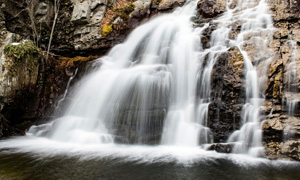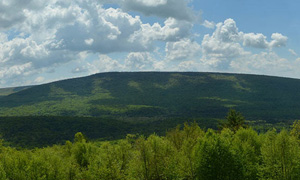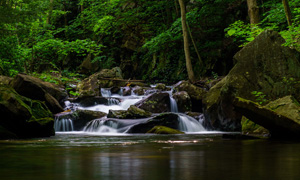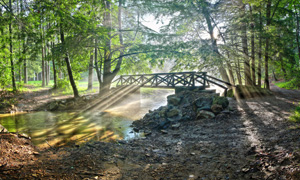
Just as forests provide physical resources that we rely on daily, often used with little thought or lack of appreciation, there are other invaluable benefits that seem even less tangible. The world is hectic, busy, and often anxiety-provoking. When we pause and realize there’s a need to shed life’s burdens, we will usually find that we look to mountains and forests as a place of escape, refreshment, and healing. Seeking interior forests away from sight and sound of man can provide this getaway and Pennsylvania’s State Forests always stand available with millions of acres to explore. This exploration is obtainable through the many access points and miles of trail throughout the forest. Arguably the best way to find this experience is on one of the 18 designated State Forest Hiking Trails (SFHTs).
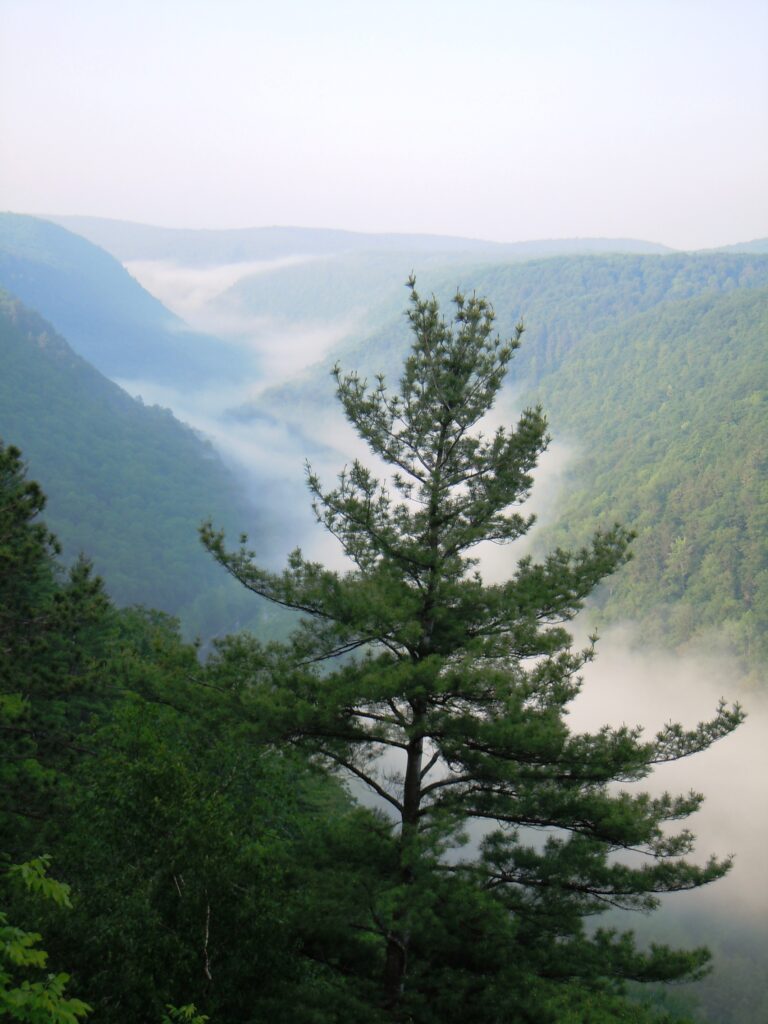
Photo by Sam Rob, Leonard Harrison State Park
While there are thousands of miles of hiking trails on state forest land, these State Forest Hiking Trails sit apart and are of regional importance, with specific management guidelines, and often feature the best vistas, forests, and wildlife viewing. Together, these total over 792 miles, and most are longer-distance trails that can be backpacked, with opportunities for day hikes, as well. Many interconnecting side trails can be used to form your own hike and adventure.
Trails situated in the Northcentral part of the state within the PA Wilds reach into some of the most remote forests in this part of the country, offering what many would consider a wilderness experience. However, each person’s definition of escape and experience of wild character can be different. One can find beauty and peace along the four-mile Rocky Knob Trail in Michaux State Forest where this short trail provides a welcome respite from daily life while still being easily accessed and attainable. Progressing further, one could backpack the 90+ mile Donut Hole Trail in Sproul State Forest and likely not see another person on a multi-day trek.
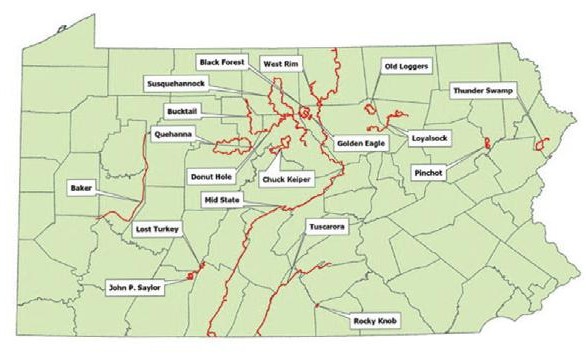
History
The 18 State Forest Hiking Trails have a history rooted in passion, respect, and love for the wild character of Pennsylvania’s state forests. Most of these trails were laid out and built in the 1970s and into the early 1980s, often with extensions or modifications since. A few of them have an earlier start, including the Loyalsock Trail which had original segments opening as early as 1951 when laid out by a local Boy Scout troop. The Alpine Club of Williamsport was formed shortly after to help steward the trail. Efforts to create the Susquehannock Trail System began as early as 1966 with a formal trail club created a year later. The Tuscarora Trail was also constructed in the 1960s, having been laid out as a possible alternate route for the Appalachian Trail — which was experiencing encroachment issues at the time.
Some trails were laid out largely by Bureau of Forestry staff while others may have been led in part by passionate volunteers. The common theme for most was the involvement of various forms of programs intended to provide employment or learning opportunities for youth and young adults such as the Youth Conservation Corps (YCC) and the Young Adult Conservation Corps (YACC). Bob Webber, who helped lay out and construct many trails in the Tiadaghton State Forest, would often speak fondly of his times leading these groups. Likewise, those who participated were influenced by the work for years to come. This is a testament to the importance of those programs and similar ones, such as the Pennsylvania Outdoor Corps (POC), that continues today.
Since their creation, these trail systems have been popular and beloved by many. Bob Webber would tell of the many hikers that flocked to the Black Forest Trail in the 1970s, with cars lining Slate Run Road that exceeded even the numbers today, and of backpackers frequently using his cabin’s front yard, which was along the Black Forest Trail, as a camping spot, before the trail was relocated below their home. Despite the consistent use and love these trails receive, there always seems to be innumerable opportunities to escape the crowds and find locations where you’re likely to see more bear or rattlesnakes than you are people, and where you’ll enter places so remote and pristine that you may feel like you’re the first person to ever view the landscape.
Foot travel over a remote primitive trail brings an exhilaration, an aliveness that cleanses us of our worldly woes and restores our spirit. The Mid-State Trail was created to foster these simple, natural, spiritual experiences, so that we may all enjoy a greater respect for nature and therefore protect nature for all future generations. –Dr. Thomas Thwaites, Father of the Mid State Trail
Features
State Forest Hiking Trails boast too many unique features to truly count but a minimum of 97 vistas, 10 waterfalls, and 14 trail bridges are inventoried on various trail maps and resources. Hikers may pass wetlands with uncommon plants or animals, enter old growth forests, travel past historic fire towers and along abandoned logging railroad grades, or even skirt daunting cliffs and boulders the size of houses. For those lucky enough, you may even spot an elk in certain areas of the state.
Another unique feature for nature lovers is that these trails provide the best access to some of the most remote places in Pennsylvania. In fact, 23% of state forest hiking trails are located more than half a mile from the nearest road, with 15 miles stretching a full mile or more from any roadway. This level of solitude is rare in the eastern United States — especially in a state crisscrossed by over 120,000 miles of roads. Hikers seeking peace, quiet, and natural beauty away from the bustle will find it here.
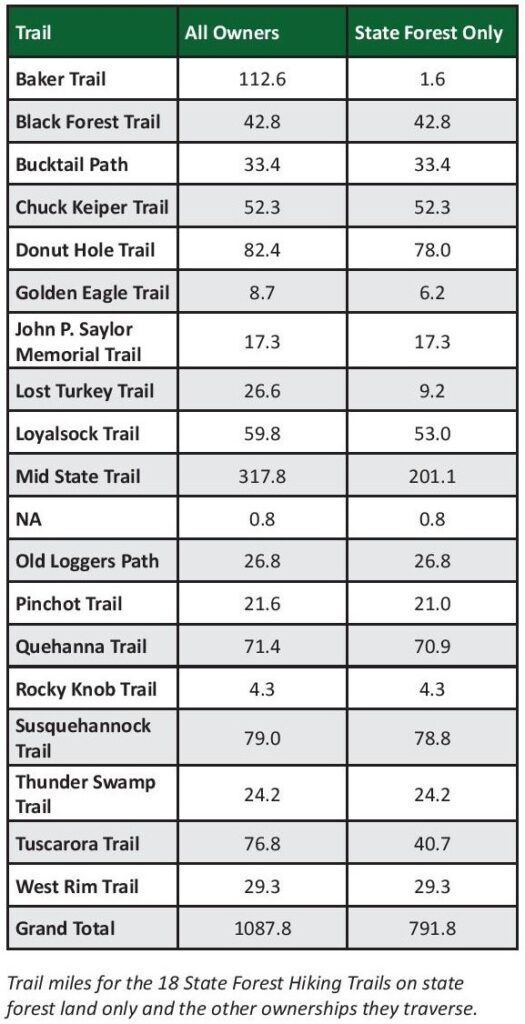
Planning Routes and Camping
The State Forest Hiking Trails can be section hiked, through hiked in a multi-day trip, or simply used to access an area of interest. These trails are interconnected with many other shorter trails that can be used to form nearly limitless unique routes. Some of the SFHTs in the PA Wilds even have designated connector trails.
For those looking to visit these trails, it is important to research the trails and area, attain maps and directions, and have a detailed plan. Helpful information can be found Staying Safe page of the DCNR website. For multi-day treks, be realistic of your abilities and determine possible campsite locations ahead of time. SFHTs may traverse different ownerships at times who may have unique rules and regulations where camping may not be permitted. While on state forest land, observe Leave No Trace Ethics and abide by state forest rules and regulations and any local closures. For more information on primitive camping see X. Remember, DCNR staff are always available to answer questions and provide information and resources.

Photo by @OneEyeWanderz
Management
The Bureau of Forestry aims to provide a wide variety of user experiences while protecting valuable natural resources. A specific goal in the bureau’s new strategic plan, Forests for All, is to provide diverse, sustainable, forest-based recreation on state forest lands. Many kinds of recreation activities occur and for those who seek hiking opportunities, the State Forest Hiking Trails remain premier destinations. These trail systems are foot traffic only, except for some sections that may be collocated with shared use trails for short distances. Applying this regulation to this small subset of the over 5,000 miles of trail on state forest land allows for retention of wild character and one of the most basic recreation forms – walking and hiking.
The bureau also provides for forest management buffers in many cases, adding to the significance of these trails, and cooperative maintenance agreements with various hiking clubs. A strategy in Forests for All is to strengthen planning and management systems to support sustainable recreation. As such, the bureau will continue to seek to understand visitor expectations and values and monitor and manage sustainability impacts. Continued improvements to improve sustainability of these trail systems will ensure they’re open and enjoyable to the public now and into the future.
Needs
The State Forest Hiking Trails are a treasure for nature lovers and adventure seekers, but they require maintenance, funding, and overall stewardship. Individual volunteers, organized trail clubs, and Friends groups contribute countless hours and raise significant funds for these trails and others across the state forest system. For those interested in helping keep trails open and in good shape visit the DCNR Conservation Volunteers webpage to learn more about volunteering and reach out to the local forest district office, the Pennsylvania Parks and Forests Foundation, and Keystone Trails Association. There are numerous opportunities including physical trail maintenance, record keeping, drafting or distributing educational materials, leading interpretive hikes, and more.
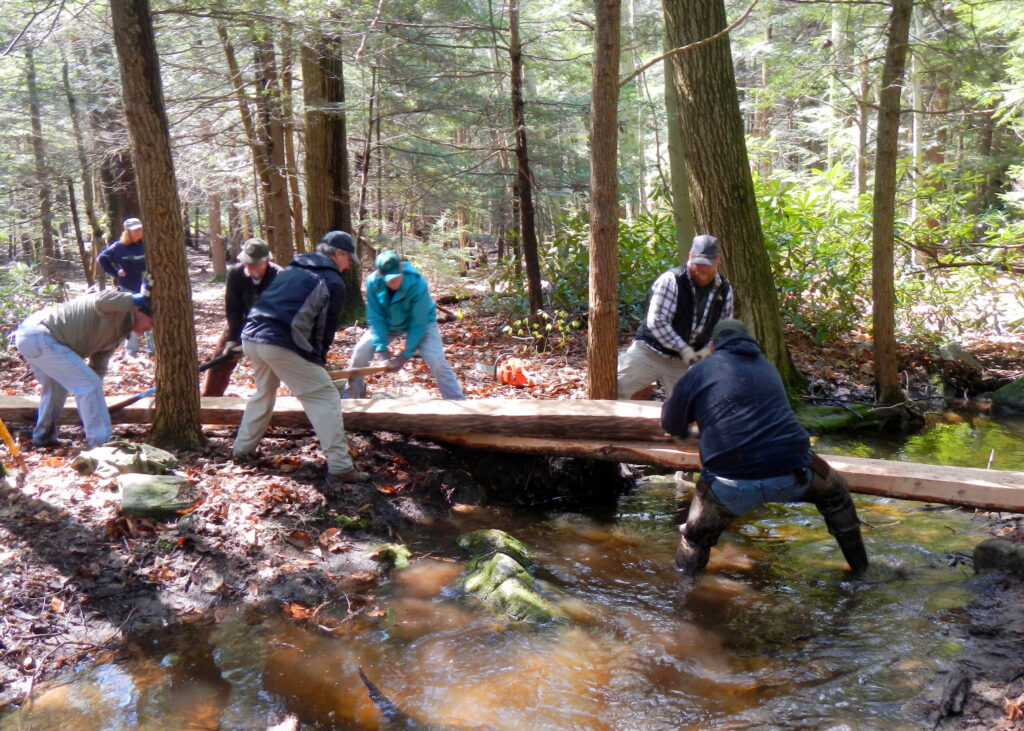
Laurel Ridge State Park volunteers help construct a trail bridge.
Conclusion
We are reminded in the classic John Muir quote that in every walk with nature, one receives far more than he seeks, and this will hold true for any visit to one of the State Forest Hiking Trails. With an abundance of solitude, variety of scenery, and numerous miles, the trails always offer more than expected. Take the opportunity to step out and experience it for yourself.
Written by Matthew Crosbie, Bureau of Forestry, Department of Conservation and Natural Resources
Article first appeared in the 2025 Summer Newsletter found here.

